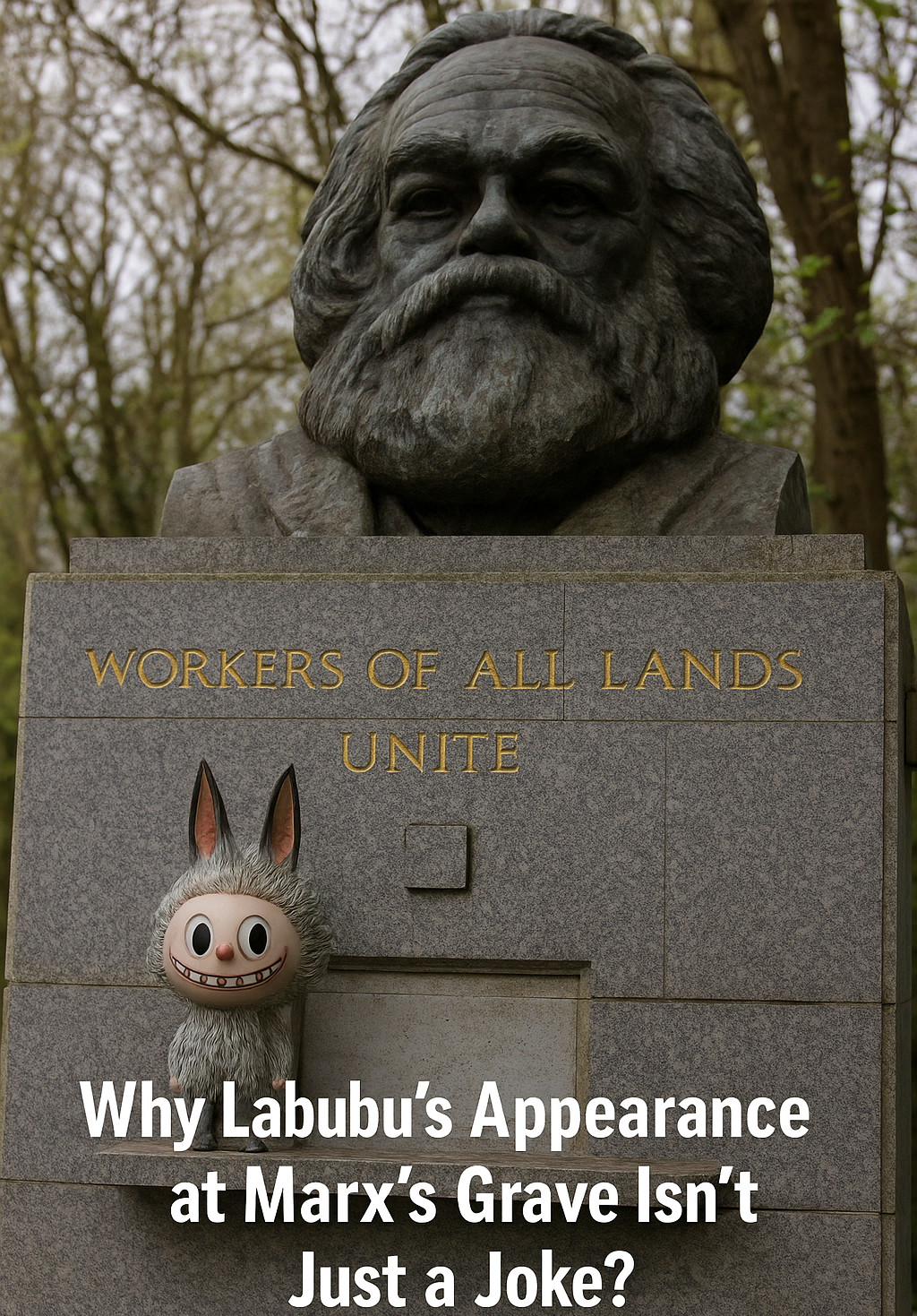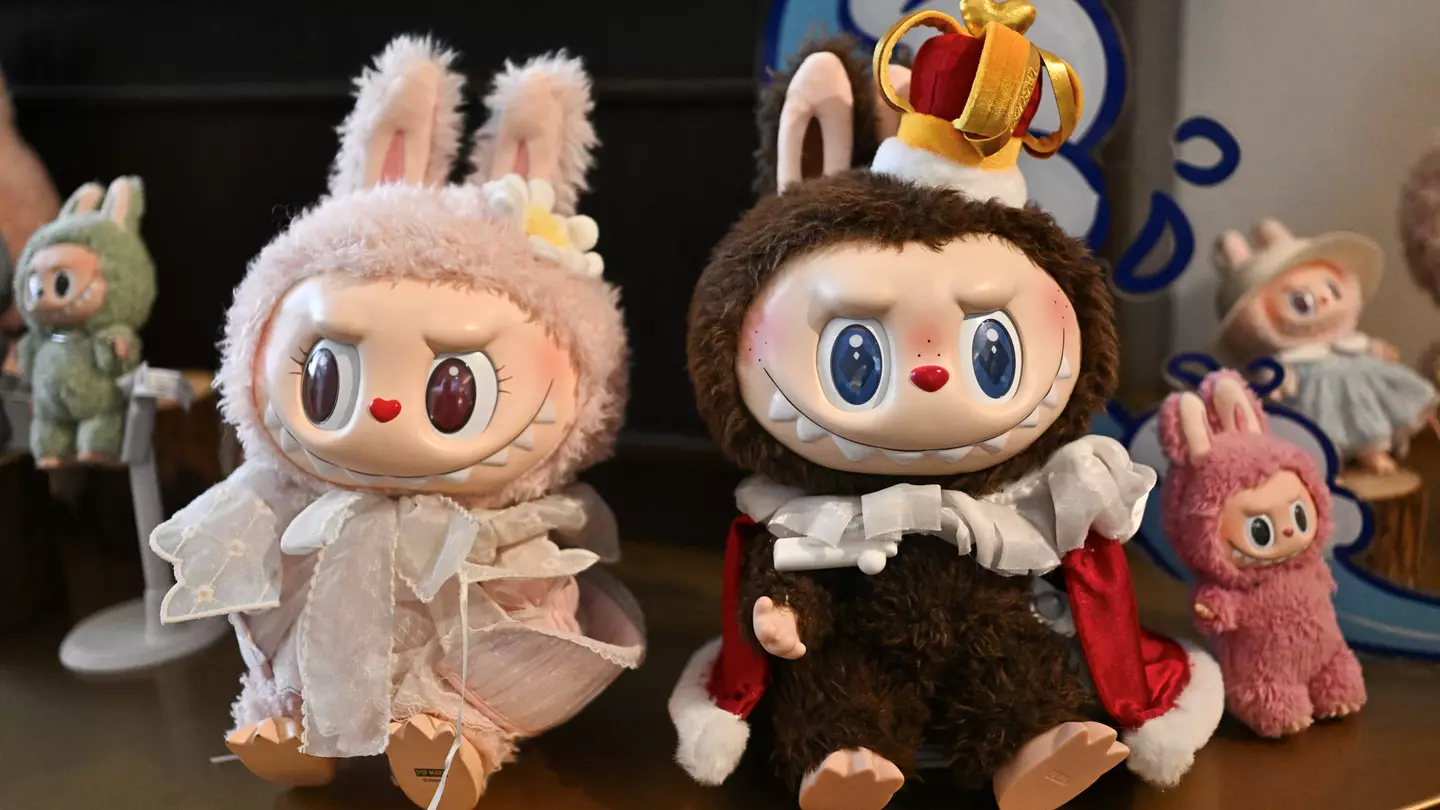Who Put a Labubu Doll on Karl Marx’s Grave and Why Is the Internet Obsessed?
A Labubu doll on Karl Marx’s grave sparks viral chaos - was it protest art or meme culture at its peak? Explore the surreal collision of capitalism, collectibles, and communism’s legacy in this deep dive into Gen Z irony, internet symbolism, and the politics of postmodern humor.

–Written by Lavanya, Deep Dive Investigative Contributor – Allegedly The News
BERLIN, July 22, 2025
A Plush Monster, a Philosopher’s Tomb, and the Birth of a Meme
It began with an image. An odd, unsettlingly cute doll, wide-eyed and cartoonishly mischievous, sat on Karl Marx’s grave in London’s Highgate Cemetery. The photo spread rapidly across X (formerly Twitter), Reddit, TikTok, and various meme groups, prompting questions like: “Who put a Labubu on Marx’s grave?”
What might seem like a random act of toy placement quickly became one of 2025’s most symbolic and controversial viral moments. For some, it was simply a joke; for others, a haunting symbol of capitalism's victory. But for most of Gen Z, it was prime meme material — absurd, ironic, and layered with meaning.
Where Did This Start? Tracing the Origins of the Viral Image
The first known post popped up on July 18, 2025, on X (Twitter), shared by a Berlin-based artist who claimed to have visited Highgate Cemetery the day before. The photo showed a small Labubu plush resting at the foot of Marx’s imposing tombstone, its big, toothy smile directed upward beneath the philosopher’s bronze bust.
The caption: “Late-stage capitalism speedrunning irony.”
From there, TikTok creators joined in, reworking the image with Karl Marx quotes, K-pop edits, and Pop Mart unboxing videos. One TikTok video using the viral image with Lana Del Rey’s "Born to Die" racked up over 4.1 million views within 48 hours.
What Even Is Labubu?
Labubu is part of the MONSTERS series created by Hong Kong designer Kasing Lung. It became popular and mass-produced by the toy company Pop Mart. Originally a niche vinyl figure in East Asian toy scenes, Labubu skyrocketed in global popularity by 2023, aided by:
- Blind box drops that made each toy a rare collectible.
- Celebrity endorsements (seen on BLACKPINK’s Lisa, Billie Eilish’s bag charms).
- TikTok trends that gave the dolls new life.
According to Vanity Fair, Labubu collectibles have sold for over $150,000 at online auctions. The doll’s mix of mischief, innocence, and strangeness made it the ideal representation of Gen Z’s taste for surrealism.
But Labubu is not just an innocent toy. Online rumors linked it to the Mesopotamian demon Pazuzu, citing its sharp teeth and unsettling stare - an urban legend that has been debunked but gained traction on TikTok. Others pointed out eerie parallels with predictions from The Simpsons and Y2K nostalgia.

The Ironic Collision of Capitalism and Communism
Placing a commercialized, limited-edition plush toy on the grave of the most famous critic of capitalism is, at best, tone-deaf. At worst, it’s a postmodern mic-drop.
Karl Marx’s grave is not just a burial site; it’s a sanctuary for leftists, union leaders, and academic visitors. His tomb reads: “Workers of all lands, unite!”
Now, above those words sat a symbol of hyper-consumerism, a doll often resold for 50 times its original price. What message was being sent?
Many interpreted it as a commentary on how capitalism has not only outlasted Marx but also commodified his memory. Others argued it showed that ideology has become a brand and that revolution is just another aesthetic.
Meme Culture as Modern Ideology
What’s intriguing is not just the image itself but the reaction it sparked.
TikTok users mashed up the photo with quotes such as:
“The philosophers have only interpreted the world in various ways. The point, however, is to vibe.”
— @genzmarxist
Key Stats:
First posted: July 18, 2025 (X/Twitter)
TikTok Views: 4.1M+
Reactions: “Late capitalism wins,” “Ironic Marxism,” “It’s giving Lenin-core”
Top Threads:
X post by @tolstoybb
NDTV viral analysis
Reddit threads on r/ABoringDystopia debated whether it served as a political protest or was simply a prank by Pop Mart fans. Instagram meme pages gave the incident meme status alongside Bin Laden’s laptop anime downloads and the Pope in Balenciaga.
This moment showcased Gen Z’s meme literacy, which is not superficial; it carries meaning. They use absurdity to expose contradictions in culture, capitalism, and ideology.
Is It Protest, Performance, or Sh*tposting?
We may never know who placed the doll, but numerous theories exist:
- Protest art: Some feel it was a political statement highlighting the emptiness of today’s ideological institutions.
- Brand guerrilla stunt: Could Pop Mart or a fan have done it to promote their brand?
- Random humor: The simplest theory suggests a tourist left it as a joke.
Yet in 2025, meaning is flexible. One viral user commented:
“If Banksy had a TikTok, he’d probably do this.”
Consumerism Has Absorbed the Revolution
If the 2000s brought us branded rebellion (think Che Guevara shirts in malls), the 2020s have ushered in ironic rebellion, where protest is subsumed by aesthetics.
Placing Labubu on Marx’s grave is less about honoring or mocking him, and more about documenting the absurd reality in which we live:
- Billionaires quote Marx during layoffs.
- NFTs fund activist campaigns.
- And now, plush demons rest on revolutionary graves.
It’s not that Labubu caused Marx's demise. It’s that capitalism has rebranded revolution as content.

When Symbols Collide: Other Bizarre Moments Like This
This isn’t the first time pop culture has collided with political significance:
- Hello Kitty balloons at Tiananmen Square memorials.
- Barbie dolls were left at Margaret Thatcher’s statue.
- A Minion plush placed at a Berlin Wall memorial.
- A SpongeBob backpack zip-tied to a Hiroshima peace exhibit.
- And now, Labubu on Marx.
These surreal contrasts are both funny and disturbing — a reminder that history is now part of the content feed.
The Real Question: Is There Any Meaning Left?
When Marx discussed commodity fetishism, he probably never imagined his grave would host one. But here we are.
What began as a strange, viral image has turned into a reflection — forcing us to confront this uncomfortable truth: We exist in a world where ideology is entertainment, and collectibles hold more power than manifestos.
The moment with Labubu on Marx didn’t mean one thing. It can mean everything and nothing, like most memes today.
And perhaps that’s the point.
Final Reflection: Plush Toy, Dead Philosopher, and Our Lost Compass
Karl Marx might not have believed in an afterlife. But if he could see the Labubu doll on his grave, would he laugh, cry, or write another volume of Das Kapital?
The real horror isn’t that capitalism placed a toy there. It’s that it feels completely normal.
Our generation doesn’t just witness irony - we live within it. Whether Labubu was left as a joke or as a statement, it has become the perfect metaphor for our confusion about ideology, the obsession with content, and commodified rebellion.
Marx’s grave has gone viral. And it says more about us than about him.
What Does This Plush Really Say About Us?
Is the viral Labubu-on-Marx moment just another absurd meme in this age of content overload, or does it serve as a striking example of how Gen Z uses surreal humor to critique power, ideology, and history? When revolution becomes an aesthetic and irony acts as activism, are we witnessing cultural decay or an evolution of political expression?




